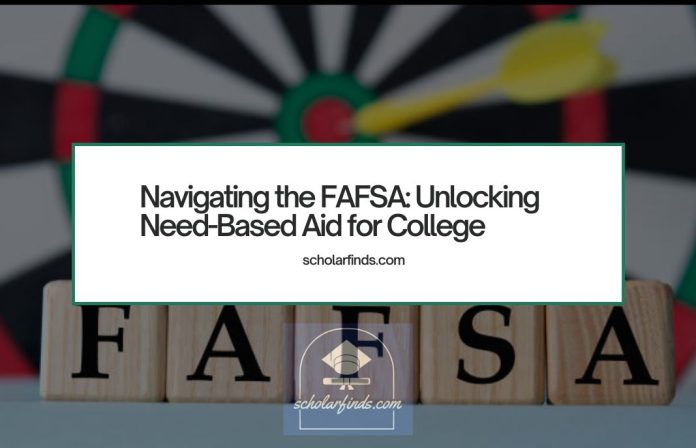Introduction
Navigating the FAFSA: Unlocking Need-Based Aid for College – Applying for college financial aid can seem like a daunting task, especially when it comes to completing the Free Application for Federal Student Aid (FAFSA). However, the FAFSA is an essential step in securing need-based aid, including scholarships, grants, and loans that can make college more affordable. In this guide, we’ll walk you through the FAFSA process step by step, explain what information you need, and address common concerns to help you unlock the financial aid you deserve.
What is the FAFSA?
The FAFSA is the primary form used by the U.S. Department of Education to determine your eligibility for federal student aid, including need-based scholarships, grants, work-study programs, and federal student loans. Many colleges and states also use FAFSA information to award their own financial aid.
- Eligibility: U.S. citizens and eligible non-citizens, including permanent residents, can apply.
- Purpose: Assesses your family’s financial situation to determine how much financial aid you qualify for.
- Outcome: After submitting the FAFSA, you will receive a Student Aid Report (SAR), which summarizes your financial information and includes your Expected Family Contribution (EFC).
Step-by-Step Guide to Completing the FAFSA
Completing the FAFSA may seem complicated, but by breaking it down into manageable steps, you can navigate the process with confidence.
1. Create an FSA ID
Before you begin the FAFSA, you’ll need to create a Federal Student Aid (FSA) ID. This is your username and password that allows you to access and sign the FAFSA online.
- Who Needs an FSA ID: Both the student and one parent (if the student is a dependent) will need to create their own FSA IDs.
- How to Create: Visit the FSA ID website, provide your personal information, and choose a secure password.
2. Gather Required Information
To complete the FAFSA, you’ll need to have several important documents and pieces of information on hand.
- Social Security Number: For both the student and parent.
- Driver’s License Number: If you have one.
- Federal Tax Information: Including your most recent tax returns, W-2 forms, and records of untaxed income. If your parents are separated or divorced, use the information from the parent you lived with most during the past year.
- Bank Statements and Investment Records: Information on cash, savings, checking account balances, and investments.
- School Codes: List the colleges you’re applying to by their Federal School Code, which you can find on the FAFSA website.
3. Start the FAFSA Application
Once you have your FSA ID and necessary documents, you can start the FAFSA application online at FAFSA.gov.
- Select the Right FAFSA Year: Make sure you’re filling out the correct form for the academic year you’ll be attending college.
- Input Personal Information: Enter your basic demographic details, including your name, date of birth, and contact information.
- Enter Financial Information: Use the IRS Data Retrieval Tool (DRT) to import your tax information directly into the FAFSA, or enter the information manually.
- List Your Schools: Add up to 10 schools where you want your FAFSA information sent. You can always add more schools later if needed.
4. Sign and Submit the FAFSA
After completing all sections of the FAFSA, review your information carefully to ensure accuracy. Then, sign the form using your FSA ID and submit it electronically.
- Confirmation Page: After submitting, you’ll receive a confirmation page. Save this for your records.
- Submission Deadline: FAFSA deadlines vary by state and school, but it’s best to submit as early as possible after the form opens on October 1st each year.
Common Concerns and FAQs
1. What if My Family’s Financial Situation Changes?
If your family’s financial situation changes significantly after you’ve submitted the FAFSA (e.g., due to job loss or medical expenses), you can contact the financial aid offices of the colleges you applied to and request a review of your financial aid package.
2. Do I Need to Complete the FAFSA Every Year?
Yes, you need to submit the FAFSA every year you’re in college to continue receiving financial aid. Fortunately, the renewal process is typically faster than the initial application.
3. What if I Make a Mistake on the FAFSA?
Mistakes happen, but they can be corrected. After submitting the FAFSA, you can log back into the FAFSA website and use the correction feature to update your information.
4. What Happens After I Submit the FAFSA?
After submission, you’ll receive a Student Aid Report (SAR) that summarizes your FAFSA data. Review this report for accuracy and use it to understand your Expected Family Contribution (EFC), which helps colleges determine your financial aid package.
Conclusion
Completing the FAFSA is a critical step in accessing need-based financial aid that can make college more affordable. By following this guide and staying organized throughout the process, you can navigate the FAFSA with confidence and unlock the financial resources you need to achieve your educational goals. Remember, the sooner you complete the FAFSA, the better your chances of securing aid, so don’t delay—start your application today!



